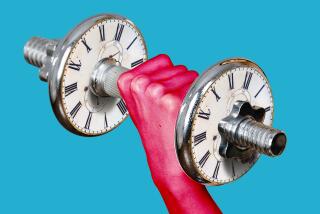A power move for strength training
- Share via
Getting out of a chair, climbing stairs, reacting to a fall -- these everyday actions take more than strength or cardiovascular fitness. They require power as well.
But this distinction can be lost on many people. Professional athletes know the importance of developing power, as do researchers studying the elderly. Average gym-goers may not.
Power is the ability to exert great force in a short period of time and results in being able to move quickly and explosively, says Mark Verstegen, founder of Athletes’ Performance in Tempe, Ariz. His facility specializes in training competitive athletes, teaching them, among other things, to accelerate and change direction quickly. That ability is developed by lifting weights rapidly and helps athletes move more explosively during games and other competitions.
In short, it’s weight training at high speeds.
“Think of strength as dial-up Internet; it serves a great purpose but is slower to boot up when you need it most,” he says. “Power is your high-speed broadband connection, ready to be used instantly on demand.”
A significant degree of power is the efficiency with which your nerves communicate and your muscles respond to the need to apply force. When you lift as much weight as you can -- as in traditional strength training -- the muscles respond more slowly.
Scientists at the U.S. Department of Agriculture Human Nutrition Research Center on Aging at Tufts University have shown that strength isn’t the best indicator of muscle performance. In a 1992 study published in Clinical Science on the effects of strength training in the elderly, researchers found a 100% increase in strength but only a 28% increase in stair-climbing power among the subjects.
Since then, some researchers have come to understand that there is a velocity component to daily activities. A study published in 2002 in the Journal of the American Geriatrics Society divided 30 women in their 70s into two groups to compare the results of high-velocity strength training with traditional strength training. The study demonstrated that high-velocity training increases leg power in older women with disability more dramatically than strength training.
The most effective way to boost power is to lift weights rapidly. This trains muscles to contract quickly and react appropriately when it is necessary to exert force. But rapidly lifting a free-weight or piece of iron attached to a machine can cause inconsistent resistance and jerking, increasing the risk of injury to joints.
Unlike weight-training, air-pressure resistance training has a smoothness and consistency, and it could be the answer. In the 1970s, Dennis Keiser, a mechanical engineer, began designing weight-stack equipment to compete with Nautilus weight-training machines. Today, strength and conditioning professionals who work with athletes have come to the same conclusion as researchers on aging, and more than a third of professional football, hockey and baseball teams use some type of Keiser power equipment.
Many health clubs, however, don’t offer air pressure equipment to their weightlifting members.
Mike Boyle, a Boston-based strength and conditioning coach, says there are other ways to train for speed of movement. Medicine balls, resistance bands or simply climbing stairs at a rapid pace all can be used as forms of power training.
He cautions that power training is relative: “The important point is that we need to train as fast as our clients are physically capable of going.”






